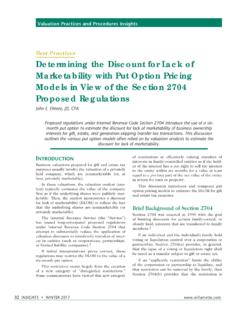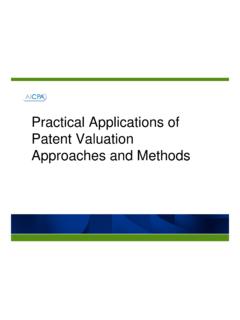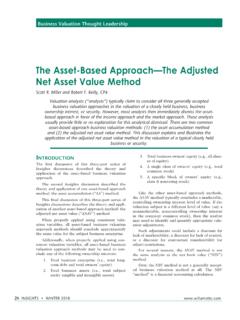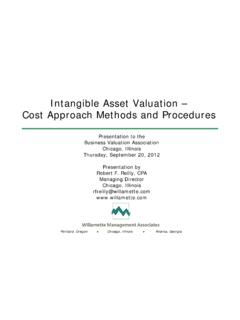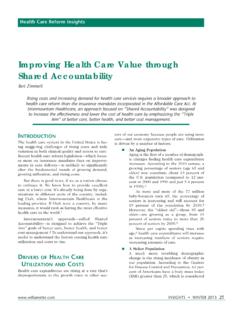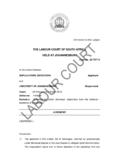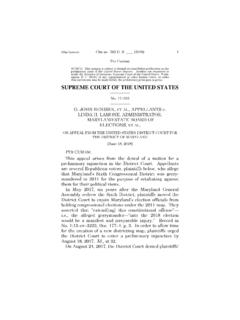Transcription of Business Breakups: Terminating Ownership …
1 Www .willamette .com INSIGHTS SUMMER 2011 53 Business breakups : Terminating Ownership Interests in Closely held BusinessesRobert J. McGaughey, Litigation InsightsIn the current market, liquidity is everywhere. Large banks pooled mortgages that converted illiquid mortgage notes into liquid securities. Buying and selling stocks is easier and less expensive than ever. However, one investment class that has not seen increased liquidity is investments in closely held businesses. Although these investments may provide owners with pride, a job, or above-market returns, investments in closely held businesses are among the least liquid investments available. Forensic analysts, legal counsel, Business owners, and the Internal Revenue Service are often concerned with how quick, how easy, at what price, and at what cost, the owner of a noncontrolling Ownership interest in closely held company can sell his or her shares? This discussion presents some of the more common methods available to both controlling owners and noncontrolling owners to sell or otherwise dispose of their investment in the closely held company.
2 As summarized throughout this discussion, there are limited methods for noncontrolling owners to cash out of their investment in a closely held company. Most methods available to noncontrolling owners involve litigation, which can be costly and can involve an uncertain owners of minority interests become dissatis-fied with those in corporate control of a publicly trad-ed corporation, those owners can simply sell their shares and immediately terminate their relationship with the corporation. Such is not the case for owners of minority interests in closely held market for minority interests in closely held businesses is negligible. Very often, the only persons interested in acquiring a minority Ownership inter-est are the majority owners of that , when majority owners become unhap-py with minority owners, there are only a few rec-ognized methods for forcing the minority owners to relinquish their Ownership interests in the Business discussion explores a few of the methods available for Terminating the relationship between majority owners and minority owners in closely held this discussion, Oregon is used to provide illustrative examples of methods to termi-nate Ownership interests in closely held businesses.
3 Every state has unique statutes and case law with regard to Terminating Ownership interests in closely held , statutes and case law are often similar between states. Therefore, although this discussion focuses on Oregon, the methods discussed herein may be applicable to other five Business breakup methods presented in this discussion include the following:1. Negotiated resolution2. Buy-sell agreements and other contracts3. Squeeze-out mergers4. Actions arising out of oppression and dead-lock5. Break-ups among members in an LLC54 INSIGHTS SUMMER 2011 www .willamette .comnegotiAted resolutionThe simplest and least costly method for severing the Business relationship is through negotiations. Many of the methods discussed later in this discus-sion are very costly in terms of legal fees as well as in terms of the time and emotional involvement of the owners an acceptable deal between the par-ties even though the end result may not be fully satisfactory to either party is often quicker and less costly than resorting to litigation.
4 There are a number of mediators and professional organiza-tions (1) that deal with closely held businesses and (2) that can facilitate these in a negotiated resolution, there are tech-nical legal and accounting issues that should be addressed fairly early in the negotiation process. Therefore, it is advisable to involve both legal and accounting assistance early, even if the parties are negotiating directly with each AgreeMents And other contrActsIt is common for shareholders in closely held cor-porations to negotiate and sign a buy-sell agreement at a limited liability company, the operating agreement often includes a mechanism for terminat-ing the relationship between the a buy-sell agreement provides that the corporation s board of directors will periodically set a buyout price. It has been this author s experi-ence that the board often forgets to set a new price each , when the falling out occurs, the last board pronouncement on value has often occurred many years prior to the proposed buyout.
5 The last value set by the board may bear little relationship to the current value of the is very important for the board of directors to revisit the issue of value each and every year, or to revise the buy-sell agreement to have the value set in a manner that does not require periodic reviews of this value by the board (such as having the value of the shares determined by independent appraisal).Right of First RefusalA buy-sell agreement usually contains a provision that gives the corporation (and sometimes other shareholders) a right of first refusal. A right of first refusal is a provision that gives the corporation the right to match any third-party offers to purchase the shareholder s shares. This provision exists primarily to make it virtually impossible for a shareholder to sell shares to a third A right of first refusal provision does not usually help in the event of a fall-ing out between the ClausesBuy-sell agreements frequently contain a provision that gives the corporation the right but usually not the obligation to buy out a shareholder s shares in the event in , a buy-sell agreement requires the corporation to buy out the shares of the deceased shareholder.
6 However, this provision is usually cou-pled with a requirement that the corporation buy life insurance on the shareholders. This provision is usually not helpful in the event of shareholder or DisabilitySometimes a buy-sell agreement contains a provi-sion giving the corporation the right but not the obligation to purchase the shares of a shareholder/employee who retires or becomes disabled. Since this provision does not give the minority share-holder the right to require that his/her shares be purchased, it is not usually helpful in a Business , the definitions of retirement and disability in the buy-sell agreement usually restrict this provision to a true retirement or of EmploymentSometimes a buy-sell agreement contains a provi-sion that provides for the purchase of a minority shareholder s shares in the event that employment is terminated. Often, distinctions are made for termination by the corporation for cause and without cause, and for terminations initiated by the employee.
7 Obviously, the specific wording in the buy-sell agreement will these circumstances, a buy-sell agreement frequently includes a formula for valuing the shares of the departing shareholder. If such a provision exists, it is very important to periodically revisit that formula to make sure that the formula still makes sense for the Business at its current level of development and in current economic Buy-Outs ClausesOccasionally when a corporation has two equal owners, a buy-sell agreement may contain a provi-sion that either shareholder can cause a buyout by www .willamette .com INSIGHTS SUMMER 2011 55(1) naming a price and (2) giving the other share-holder a short period in which to decide whether to become the buyer or seller at that a provision works best in corporations with two equal owners. It can sometimes be used when the Ownership is close, but not exactly equal for example, when there are 51 percent/49 percent in such a situation, it is important to address the issue of whether or not a control price premium or discount for lack of Ownership control is forced buy-out mechanism does not work well if the two owners own substantially different percentages of the stock or where there are multiple the event of a falling out between Business own-ers, contracts between those Business owners such as buy-sell agreements, operating agreements, and occasionally the bylaws should be reviewed to see if there is a contractual mechanism for resolving the dispute, or for giving one owner the right to force the other owner to buy or sell his/her Ownership MergersIf the majority owners wish to force the minor-ity owners to sell their shares.
8 There are forms of corporate reorganization that can accomplish this goal. The most common of these reorganizations is known as a squeeze-out merger. 3In a classic squeeze-out merger, the major-ity owners contribute their shares in the company (OldCo) to a new corporation (NewCo). After this transfer, NewCo becomes the majority owner of OldCo s , the two corporations adopt a plan of merger, merging OldCo into NewCo and requiring all individual shareholders ( , the minority owners) to be cashed out at the fair value of their to the adoption of the plan of merger, the majority owners usually engage a Business valuation firm to estimate the fair value of the shares. The statute requires those in control to offer a fair price for the minority owner s shares only a short time into the process, so a stock valuation is often the first step is also true because, soon after the process begins, those in control will be irrevocably commit-ted to buying out the minority owners at a fair price, making it important to having an idea going in as to what that purchase price will likely types of reorganization plans give rise to dissenter s rights, and a process covered by Required by Oregon StatuteIn Oregon,4 if a corporation proposes a squeeze-out merger or similar reorganization, the corporation must notify its shareholders of the right to dissent before the shareholder meeting when the vote to merge will occur.
9 In order to dissent under such cir-cumstances, a dissenting shareholder must deliver a written notice to the corporation before the vote is written notice must include a demand for payment in exchange for the shareholder s shares in the event the action is effectuated at the share-holder the shareholders fail to take the proposed action, the corporation need do nothing more with regard to any dissenting if the shareholders then vote and autho-rize an action giving rise to dissenters rights, the corporation must send a dissenters notice to all shareholders who previously dissented and must do so within 10 days of the shareholder vote authoriz-ing the notice must:1. state where the shareholder must send a payment demand,2. state where and when the shareholders stock certificates must be deposited,3. describe any transfer restrictions applicable to uncertificated shares,4.
10 Supply a form for demanding payment, and 56 INSIGHTS SUMMER 2011 www .willamette .com5. set a date by which the corporation must receive the payment demand (which can be no less than 30 and no more than 60 days after the date the dissenters notice is deliv-ered to the dissenters).If the proposed action is taken without a share-holder vote, the corporation must inform its share-holders of the action taken and deliver this dis-senters notice to all shareholders entitled to assert dissenters desiring payment are then required to demand payment and deposit their shares with the receipt of a proper payment demand, the corporation is required to pay each such dissenter the amount the corporation estimates to be the fair value of the dissenters shares, plus accrued interest . If a dissenter disagrees with the corporation s estimate of fair value, the dissenter may notify the corporation in writing of his or her own estimate of fair value and may demand payment of this (pre-sumably higher) amount.
